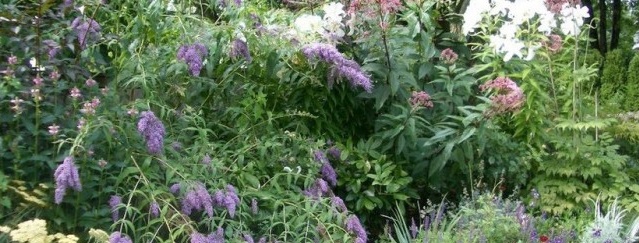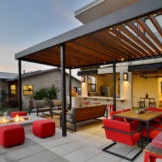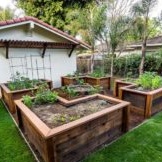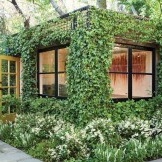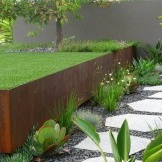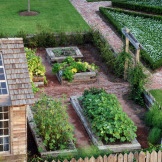Mixborder: first flowers and late berries
A garden with the same planting is not inspiring and looks boring. The mood is created by lush mixes from plants. Bright islands scattered around the site, and beautifully organized alleys, give pleasure from contemplation, and cause the corresponding emotions. It will be about making extraordinary flower beds, and harmony in a combination of completely different types.
Long-flowering multi-row planting is called a mixborder. In fact, it duplicates the function of the border, but at the same time is indicated by its own uniqueness:
- made up of numerous species;
- organized according to the scheme of multi-tier plantings. For their materialization, it is desirable to have room, but also the limitedness in meters is also not an obstacle. Width starts from 1.5 and varies up to 4 m, while the length depends solely on territorial capabilities.
- the array requires a decorative necklace, and the presence of paths inside the plantings to care for it.
The type of flower garden has been forming for many years, and its basis is perennial. When equipped with coniferous species, it looks equally attractive all year. Seasonal flowers only harmonize the background and create accents. The principle of organizing such a flower bed is loyal, but planting is subject to the rules. Randomness is excluded, and creativity is welcome.
Design requirements are determined by knowledge of the scheme of combinations of varieties, the period of flowering and placement. Instances are permissible to plant in groups in a row, to create curly compositions, adhering to three levels of vertical height. The result should be a colorful assortment of dwarf trees and shrubs, grassy and deciduous species. Compositionally goes well with a classic lawn, and naturally fits into the style of any garden.
What you should know
Although the plant mix is intended to serve as a frame for the alleys, other formats in its organization are not excluded. If it is not located near the fence, the view is accessible from opposite sides. With one-sided viewing, the foreground is occupied by creeping or undersized collections. Basically, these are seasonal or onion varieties. Further landings are grouped by rank:
- the place of perennials of medium parameters is in the center;
- panoramic perception determines the height of tall trees in the background;
- free form implies a planted middle;
- when arranging a double-sided flower garden, specimens dominating in height make up a longitudinal line;
Bearing in mind the fact that the mixborder impresses with its spectacularity from a distance, it is required to provide a border strip from half a meter wide between it and the alley.
To ensure the unfading appearance of the compositions, it is better to select specimens from the plant collection with the original color: cotoneaster, burgundy leaves of barberry, spirea. A group of shrubs welcomes a duet of conifers. In the autumn-winter panorama, they relatively compensate for the monochrome space. Mixes are organized on the relatively open side of the site with good soil. It is not permissible to create puddles during irrigation, since most of the bushes need dry soil.
In the early years, relying on intensive crown growth, plantings must adhere to the necessary interval between the roots. At the same time, it varies by tens of centimeters, both in annuals (from 20 cm) and perennial (up to 80 cm). In the beginning, seasonal flowers are planted in gaping voids, with decorated crowns they plant only small segments for color. The choice is for compact volumes of tops that are easy to cut.
Seasonal relay
Any design idea is not curled from the square.In a small area, it is possible to actually reduce the scale and adjust the project according to the goal. The process begins with planting shrubs. With this approach, the layout of the flower garden is initially determined. Thanks to tolerance for a topiary haircut, a democratic boxwood is in the lead. Among the beautiful plantings that obeys the law of the flower bed - do not actively protrude by shoots outside the designated framework, include: Iberis and Mahonia, Meira lilac, mock up, shrubby cinquefoil, and all kinds of spirea. The listed specimens of flora tolerate a haircut, and are in aesthetic agreement with other plants.
To be more specific, Forsythia and Daphnia “discover” the spring. Yellow flowers manage to bloom on branches without leaves. Then the relay goes to the Canadian irga and mountain ash with viburnum. Barberry is always ready to bring dynamism to any composition with its red leaves. In May, the lilac period ends the early fragrance. In a mild climate, rhododendrons will take root perfectly.
Spring-summer riot will be provided by ground cover: carpet phlox, stonecrops, periwinkle. Perennials will support aesthetic solidarity. Among them are the white tenderness of irises, as well as primrose, armeria, a low host, astilbe.
Closer to mid-summer, deytsiya blooms in pink and white flowers, in August lush hibiscus. In early autumn, white hydrangea balls are pleasantly shocking with their beauty. Red beads of rose hips and viburnum, yellow berries of sea buckthorn and clusters of mountain ash will decorate the late landscape of the autumn garden. Kaleidoscopic luxury colors complement the leaves of euonymus.
Assorted vegetables in a mixborder
Combinations of bushes and trees are relative to the growth parameters. It is recommended to organize a company from juniper, Christmas tree, arborvitae, fir. The “prickly” inaccessibility will be diluted with gloss of rhododendron leaves in commonwealth with ground covers, like ivy and cotoneaster.
In the project to create a shrub mix, do not ignore the proximity of flowering species. They will perfectly connect the plot and make it richer. The harmony of compatibility is important, otherwise the concentration of dominant varieties will simply visually suppress the impression. And yet, if the fantasy ensemble includes antagonist flowers, settle them at opposite ends.
- a duet of roses and lilies will bring disharmony into the overall sound;
- plaster or lavender individually make friends with both species;
- related plants include the so-called dynamic plants: daisies, marigolds, valerian;
- during planting, check the coincidence of the conditions of care regarding irrigation, soil type and top dressing;
After the bushes comes the turn of perennials. With limited square meters, it is advisable to place a bet on long-flowered flowers with a peak activity of at least 3 months: echinacea, laureate, polygon (Agastache). The gentle color of wormwood, as well as hosts and dark red heichera duplicate the volume of tree crowns in a compressed format, will fit into the bouquet in color and shape.
The void between plantings will be filled by the variegation of annuals. In the spring, islands of viols and daisies will please, a carpet of petunias, verbena will replace them. The onion flower cocktail menu is varied: crocuses, daffodils, tulips or muscari. To enhance the effect, it is better to arrange them in groups.
Front dressing
The optimal location of the shrub mixborder next to the wall of the house, the fence or on the border of the terrace. Framing will serve as sidewalk tiles, wood chocks, marble chips up to a compact mound of gravel. To do without stones, of course, is impossible.
Due to the existing natural potential - texture, color, configurations, they will outline the boundaries, complicate the visual impression, and give greater decorative effect. Edging can also be done from boulders, limestone, cobblestones, sandstones, clinker bricks and designer imagination, but without claiming leadership in the composition.
The presence on the site of a colorful strip in front of the house or along the main avenue forces to complete its formal appearance.The constancy of beauty will provide paints of Pushkin, galanthus or muscari. A little later, the proscenium will be at the disposal of hyacinths and other luxurious specimens. The next number in the flower theater are roses or lilies, or peonies. Toward the close of the season, a duet of chrysanthemums and asters will perform.
In areas of a regular type, the flower bed is enclosed in the correct forms of geometry. Boundary lines are bordered identically, but with the exception of boulders. Garden sculptures or tall vases compensate for the volume. In the landscape style, soft outlines prevail, and the mix tape is framed by smooth lines of walls of limestone and sandstone. Marble columns with climbing plants give completeness.
English version
A distinctive and interesting feature is harmony in a combination of wild and cultural specimens. This type of flower garden was formed a couple of centuries ago, and bushy flora of medicinal value - bitter wormwood, veronica, spicy rosemary, useful sage and yarrow - remains its dominant. Among the collection of perennials, narrow-leaved species are welcome. Varietal roses and some representatives from the group of indoor plants - fuchsia or pelargonium also participate in the ensemble.
There is a restriction in the intensity of the colors, due only to the pink-raspberry color with the support of lilac and blue tones. Surrounded by light stones, like limestone or sandstone, they look more than pretty.
Country style
The “village” mix should be in accordance with the local flora. With the popularity in the region of poppies or lupins, species must be duplicated in the flower garden. In order to catch your eye, use vertical structures entwined with vines with a decorative podium. Visual support will be the main varieties of shrubs and conifers. Such compositions, in accordance with the stylistic idea, are placed along the paths or the front garden. Brick, standing edge or flagstone designed to decorate the natural plot.
A rational version on a given topic is a useful flower garden with crops of garden plantings. It consists of vegetable varieties and seasonal flowering plants without claims for year-round decoration. The frequency does not at all plead with its relevance in the landscape, and the garden composition rightfully occupies a place in the list with original designs. Crops are sown in segments of 80 cm, with the removal from the adjacent beds in size of large paving slabs. Greens border a red brick necklace, and parsley with dill is served on the table. A high tier is formed by a wall of corn, mallow, or sunflower.
Themes to choose from
The coastal mixborder includes moisture-loving varieties: meadowsweet, forget-me-nots, loosestrife, high miscanthus, and winks. The format of the flower garden is limited and does not exceed 1 m in width. It is represented by dense group landings with a high density of placement and a smooth decrease along the growth line. Pebbles and boulders will complete the composition.
For the look of the “steppe” landscape, the decorative and wild species of the flora are responsible, creating a separate theme for design. Wormwood, tansy, goldenrod and a number of others make up the compositional basis with a characteristic muted violet-blue palette and a local complement of yellow. In solidarity with mossy boulders and gravel, the possibility of the presence of a Scythian figure made of their plaster, leave an enthusiastic feeling. The strongest emotions are caused by such a cocktail against the background of a molded hedge.
Fans of experimenting draw up new schemes for planting, and discover interesting opportunities for decorating the site. Try and you envy of others to make the design of your site unique.

